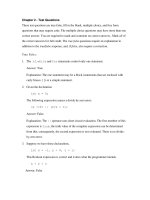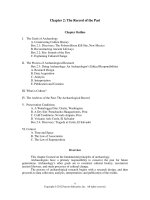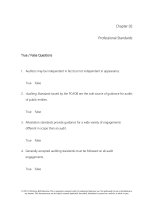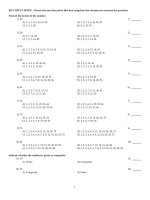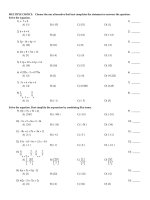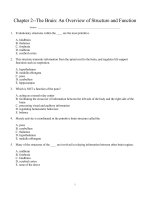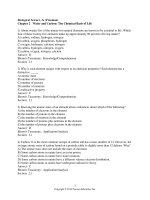Introductory chemistry atoms first 5th edition russo test bank
Bạn đang xem bản rút gọn của tài liệu. Xem và tải ngay bản đầy đủ của tài liệu tại đây (99.16 KB, 43 trang )
Introductory Chemistry: Atoms First, 5e (Russo/Silver)
Chapter 2 The Numerical Side of Chemistry
2.1 Multiple-Choice Questions
1) Identify the exact number.
A) a number of coins
B) the diameter of a coin
C) the radius of a coin
D) the mass of a coin
Answer: A
Section: Section 2.1
Learning Outcome: 2.1 Explain what an exact number is and what a measured number is.
Global Obj: G2 Demonstrate the ability to think critically and employ critical thinking skills.
2) Identify the piece of glassware that provides the least precise volume measurement of a liquid.
A) beaker
B) graduated cylinder
C) buret
D) pipette
Answer: A
Section: Section 2.1
Learning Outcome: 2.3 Explain why measured numbers always have uncertainty associated
with them.
Global Obj: G2 Demonstrate the ability to think critically and employ critical thinking skills.
3) Which of the following represents an estimated measurement?
A) A calendar week has 7 days.
B) The U.S. national debt is 6 trillion dollars.
C) There are 50 states in the United States of America.
D) My bank account contains 19 dollars and 26 cents.
Answer: B
Section: Section 2.1
Learning Outcome: 2.1 Explain what an exact number is and what a measured number is.
Global Obj: G2 Demonstrate the ability to think critically and employ critical thinking skills.
4) For the measured value 6.73 pounds, what is the degree of uncertainty?
A) +/- 10 pounds
B) +/- 1 pound
C) +/- 0.1 pound
D) +/- 0.01 pound
Answer: D
Section: Section 2.2
Learning Outcome: 2.7 Identify the degree of uncertainty in a number written in scientific
notation.
Global Obj: G2 Demonstrate the ability to think critically and employ critical thinking skills.
1
Copyright © 2015 Pearson Education, Inc.
5) How many significant figures are in 43.8001?
A) 2
B) 3
C) 4
D) 6
Answer: D
Section: Section 2.3
Learning Outcome: 2.4 Identify leading zeros and trailing zeros in a measured number.
Global Obj: G2 Demonstrate the ability to think critically and employ critical thinking skills.
6) Which one of the following numbers does not have four significant figures?
A) 1.007 g
B) 0.0007 g
C) 1.070 g
D) 1700. g
E) 1.700 g
Answer: B
Section: Section 2.3
Learning Outcome: 2.4 Identify leading zeros and trailing zeros in a measured number.
Global Obj: G2 Demonstrate the ability to think critically and employ critical thinking skills.
7) Round off 907,506 to four significant figures.
A) 9.075 × 10-5
B) 9.075 × 105
C) 9,075
D) 90,751
E) 908,000
Answer: B
Section: Section 2.3
Learning Outcome: 2.4 Identify leading zeros and trailing zeros in a measured number.
Global Obj: G2 Demonstrate the ability to think critically and employ critical thinking skills.
8) How many significant digits are present n the number 6046.2?
A) 4
B) 3
C) 5
D) 1
Answer: C
Section: Section 2.3
Learning Outcome: 2.4 Identify leading zeros and trailing zeros in a measured number.
Global Obj: G2 Demonstrate the ability to think critically and employ critical thinking skills.
2
Copyright © 2015 Pearson Education, Inc.
9) How many significant digits are present in the number 0.02560?
A) 3
B) 4
C) 5
D) 6
Answer: B
Section: Section 2.3
Learning Outcome: 2.4 Identify leading zeros and trailing zeros in a measured number.
Global Obj: G2 Demonstrate the ability to think critically and employ critical thinking skills.
10) How many significant figures are present in 0.00123, 7000, and 1.519 × 10-2?
A) 6, 4, 4
B) 4, 1, 1
C) 7, 1, 4
D) 3, 1, 4
Answer: D
Section: Section 2.3
Learning Outcome: 2.4 Identify leading zeros and trailing zeros in a measured number.
Global Obj: G2 Demonstrate the ability to think critically and employ critical thinking skills.
11) The number 0.0040600 has ________ trailing zeros.
A) 0
B) 1
C) 2
D) 6
Answer: C
Section: Section 2.3
Learning Outcome: 2.4 Identify leading zeros and trailing zeros in a measured number.
Global Obj: G2 Demonstrate the ability to think critically and employ critical thinking skills.
12) The correct scientific notation for 147.8 × 10-3 is ________.
A) 1.478
B) 1478 × 10-4
C) 1.478 × 10-1
D) 1.478 × 10-5
Answer: C
Section: Section 2.4
Learning Outcome: 2.4 Identify leading zeros and trailing zeros in a measured number.
Global Obj: G2 Demonstrate the ability to think critically and employ critical thinking skills.
3
Copyright © 2015 Pearson Education, Inc.
13) Convert 0.000001546 mi to scientific notation.
A) 1.546 × 106 mi
B) 1.546 × 105 mi
C) 1.546 × 10-5 mi
D) 1.546 × 10-6 mi
Answer: D
Section: Section 2.4
Learning Outcome: 2.6 Convert a number from standard to scientific notation and vice versa.
Global Obj: G2 Demonstrate the ability to think critically and employ critical thinking skills.
14) The number 0.0247 expressed in scientific notation is ________.
A) 2.47 × 10-4
B) 2.47 × 10-2
C) 2.47 × 10-1
D) 24.7
Answer: B
Section: Section 2.4
Learning Outcome: 2.6 Convert a number from standard to scientific notation and vice versa.
Global Obj: G2 Demonstrate the ability to think critically and employ critical thinking skills.
15) The number 0.00003007 expressed in scientific notation is ________.
A) 3.007 × 10-5
B) 3.007 × 105
C) 3.007
D) 3.007 × 104
E) 3.7 × 10-5
Answer: A
Section: Section 2.4
Learning Outcome: 2.6 Convert a number from standard to scientific notation and vice versa.
Global Obj: G2 Demonstrate the ability to think critically and employ critical thinking skills.
16) Express the number 1.06 × 10-4 in standard notation.
A) 10,600
B) 106
C) 0.0106
D) 0.000106
Answer: D
Section: Section 2.4
Learning Outcome: 2.6 Convert a number from standard to scientific notation and vice versa.
Global Obj: G2 Demonstrate the ability to think critically and employ critical thinking skills.
4
Copyright © 2015 Pearson Education, Inc.
17) The United States has the unit of currency dollars (unit symbol: $). Which of the following is
a proper expression of the value seventy seven hundred dollars +/- 1 dollar?
A) $ 7.7 × 10+4
B) $ 7.7 × 10+3
C) $ 7700
D) $ 7.700 × 10+3
Answer: D
Section: Section 2.4
Learning Outcome: 2.5 Identify the amount of uncertainty in a written measured quantity.
Global Obj: G2 Demonstrate the ability to think critically and employ critical thinking skills.
18) By how many places must the decimal point of the number 0.0000814 be moved in order to
express this same number in a standard scientific notation?
A) 4
B) 5
C) 6
D) 7
Answer: B
Section: Section 2.4
Learning Outcome: 2.5 Identify the amount of uncertainty in a written measured quantity.
Global Obj: G2 Demonstrate the ability to think critically and employ critical thinking skills.
19) For the final sum of 544.36 + 455.64, the number of significant figures is ________.
A) 6
B) 5
C) 4
D) 2
E) 1
Answer: A
Section: Section 2.5
Learning Outcome: 2.8 Correctly add or subtract numbers according to the rules of significant
figures.
Global Obj: G4 Demonstrate the quantitative skills needed to succeed in chemistry.
20) The correct answer for the operation (5.61 + 7.891 ) / 9.1 is ________.
A) 4.86
B) 4.8646714
C) 1.5
D) 5.0
Answer: C
Section: Section 2.5
Learning Outcome: 2.8 Correctly add or subtract numbers according to the rules of significant
figures and 2.9 Correctly multiply or divide numbers according to the rules of significant
figures.
Global Obj: G4 Demonstrate the quantitative skills needed to succeed in chemistry.
5
Copyright © 2015 Pearson Education, Inc.
21) Using the rules of significant figures, calculate the following: 14.8903 - 2.14 =
A) 12.750
B) 12.75
C) 13
D) 12.7503
E) 12
Answer: B
Section: Section 2.5
Learning Outcome: 2.8 Correctly add or subtract numbers according to the rules of significant
figures.
Global Obj: G4 Demonstrate the quantitative skills needed to succeed in chemistry.
22) The sum for the operation 1.2315 + 0.116 + 15.10 is ________.
A) 16
B) 16.4
C) 16.45
D) 16.4475
Answer: C
Section: Section 2.5
Learning Outcome: 2.8 Correctly add or subtract numbers according to the rules of significant
figures.
Global Obj: G4 Demonstrate the quantitative skills needed to succeed in chemistry.
23) Which of the following operations will give an answer of 50.1?
A) 29.75 + 20.3
B) 58.23 - 8.1
C) 26.255 × 1.91
D) all of the above
Answer: D
Section: Section 2.5
Learning Outcome: 2.8 Correctly add or subtract numbers according to the rules of significant
figures and 2.9 Correctly multiply or divide numbers according to the rules of significant
figures.
Global Obj: G4 Demonstrate the quantitative skills needed to succeed in chemistry.
24) Which of the following operations will not give an answer of 73.3?
A) 63.75 × 1.15
B) 90.0 - 16.67
C) 60.15 + 13.26
D) 12.161 × 6.03
Answer: C
Section: Section 2.5
Learning Outcome: 2.8 Correctly add or subtract numbers according to the rules of significant
figures and 2.9 Correctly multiply or divide numbers according to the rules of significant
figures.
Global Obj: G4 Demonstrate the quantitative skills needed to succeed in chemistry.
6
Copyright © 2015 Pearson Education, Inc.
25) The correct answer in the operation below is ________.
(30.004 cm × 14.01 g) / 6.08 cm2
A) 69.1375 g/cm
B) 69.14 g/cm
C) 69.1 g/cm
D) 69.138 g/cm
Answer: C
Section: Section 2.5
Learning Outcome: 2.9 Correctly multiply or divide numbers according to the rules of
significant figures.
Global Obj: G4 Demonstrate the quantitative skills needed to succeed in chemistry.
26) Which of the following is defined as the quantity of matter in a sample that is independent of
where it is measured?
A) weight
B) mass
C) volume
D) both A and B
Answer: B
Section: Section 2.6
Global Obj: G2 Demonstrate the ability to think critically and employ critical thinking skills.
27) Which of the following is not an SI unit that is used in chemistry?
A) s
B) K
C) kg
D) quart
Answer: D
Section: Section 2.6
Learning Outcome: 2.10a Identify the common SI units used by science.
Global Obj: G2 Demonstrate the ability to think critically and employ critical thinking skills.
28) Which is the SI unit for mass?
A) kilogram
B) pound
C) gram
D) ounce
Answer: A
Section: Section 2.6
Learning Outcome: 2.10a Identify the common SI units used by science.
Global Obj: G2 Demonstrate the ability to think critically and employ critical thinking skills.
7
Copyright © 2015 Pearson Education, Inc.
29) Which is the SI unit for temperature?
A) Fahrenheit
B) Celsius
C) Kelvin
D) either A or C
Answer: C
Section: Section 2.6
Learning Outcome: 2.10a Identify the common SI units used by science.
Global Obj: G2 Demonstrate the ability to think critically and employ critical thinking skills.
30) Which is the SI unit for length?
A) meter
B) inch
C) kilometer
D) mile
Answer: A
Section: Section 2.6
Learning Outcome: 2.10a Identify the common SI units used by science.
Global Obj: G2 Demonstrate the ability to think critically and employ critical thinking skills.
31) Which is the SI unit for time?
A) year
B) day
C) minute
D) second
Answer: D
Section: Section 2.6
Learning Outcome: 2.10a Identify the common SI units used by science.
Global Obj: G2 Demonstrate the ability to think critically and employ critical thinking skills.
32) Which is a derived SI unit?
A) J
B) m
C) K
D) s
Answer: A
Section: Section 2.6
Learning Outcome: 2.10a Identify the common SI units used by science.
Global Obj: G2 Demonstrate the ability to think critically and employ critical thinking skills.
8
Copyright © 2015 Pearson Education, Inc.
33) Which is not a derived SI unit?
A) Pa
B) J
C) C
D) s
Answer: D
Section: Section 2.6
Learning Outcome: 2.10a Identify the common SI units used by science.
Global Obj: G2 Demonstrate the ability to think critically and employ critical thinking skills.
34) The prefix used to indicate 10-12 is ________.
A) microB) nanoC) picoD) gigaAnswer: C
Section: Section 2.6
Global Obj: G2 Demonstrate the ability to think critically and employ critical thinking skills.
35) What is the prefix for the multiplier 1 × 106?
A) microB) nanoC) megaD) kiloAnswer: C
Section: Section 2.6
Global Obj: G2 Demonstrate the ability to think critically and employ critical thinking skills.
36) What is the prefix for the multiplier 1 × 10-6?
A) microB) nanoC) megaD) kiloAnswer: A
Section: Section 2.6
Global Obj: G2 Demonstrate the ability to think critically and employ critical thinking skills.
9
Copyright © 2015 Pearson Education, Inc.
37) 10 millimeters are equal to ________ nanometers.
A) 107
B) 10-7
C) 103
D) 10-3
Answer: A
Section: Section 2.6
Learning Outcome: 2.12c Convert the units of a measured quantity to some other units using
Unit Analysis.
Global Obj: G2 Demonstrate the ability to think critically and employ critical thinking skills.
38) How many kilograms are in 452 mg?
A) 4.52 × 10-7 kg
B) 4.52 × 10-4 kg
C) 0.452 kg
D) 4.52 × 108 kg
Answer: B
Section: Section 2.6
Learning Outcome: 2.12c Convert the units of a measured quantity to some other units using
Unit Analysis.
Global Obj: G4 Demonstrate the quantitative skills needed to succeed in chemistry.
39) 465.000 g is equivalent to ________.
A) 0.0465 kg
B) 465,000 mg
C) 4.65 kg
D) 465,000 ng
Answer: B
Section: Section 2.6
Learning Outcome: 2.12c Convert the units of a measured quantity to some other units using
Unit Analysis.
Global Obj: G4 Demonstrate the quantitative skills needed to succeed in chemistry.
40) Which of the following numbers expresses the value 2600. calories with both the correct
units and proper scientific notation?
A) 2.6 × 104 kcal
B) 2.600 × 103 cal
C) 2.60 × 103 mcal
D) 26 × 102 dcal
Answer: B
Section: Section 2.6
Learning Outcome: 2.12c Convert the units of a measured quantity to some other units using
Unit Analysis.
Global Obj: G2 Demonstrate the ability to think critically and employ critical thinking skills.
10
Copyright © 2015 Pearson Education, Inc.
41) In order to convert 121 dm to mm one needs to multiply by ________.
A) 107
B) 102
C) 10-2
D) 10-5
Answer: B
Section: Section 2.6
Learning Outcome: 2.6 Convert a number from standard to scientific notation and vice versa.
Global Obj: G4 Demonstrate the quantitative skills needed to succeed in chemistry.
42) Which of the following does not measure temperature?
A) °C
B) °F
C) K
D) J
Answer: D
Section: Section 2.6
Global Obj: G2 Demonstrate the ability to think critically and employ critical thinking skills.
43) 68 °F is equal to ________.
A) 37 °C
B) 32 °C
C) 25 °C
D) 20. °C
Answer: D
Section: Section 2.6
Learning Outcome: 2.13d Algebraically rearrange a mathematical equation to solve it for a
desired variable.
Global Obj: G4 Demonstrate the quantitative skills needed to succeed in chemistry.
44) 40. °C is equal to ________ K.
A) 313
B) 293
C) 263
D) 233
Answer: A
Section: Section 2.6
Learning Outcome: 2.13d Algebraically rearrange a mathematical equation to solve it for a
desired variable.
Global Obj: G4 Demonstrate the quantitative skills needed to succeed in chemistry.
11
Copyright © 2015 Pearson Education, Inc.
45) A liquid boils at 68 °F at one atmosphere pressure. This is equal to ________ K.
A) 341
B) 205
C) 253
D) 293
Answer: D
Section: Section 2.6
Learning Outcome: 2.13d Algebraically rearrange a mathematical equation to solve it for a
desired variable.
Global Obj: G4 Demonstrate the quantitative skills needed to succeed in chemistry.
46) Which is the lowest temperature?
A) 40 °C
B) 104 °F
C) 313 K
D) All of them are about the same.
Answer: D
Section: Section 2.6
Learning Outcome: 2.13d Algebraically rearrange a mathematical equation to solve it for a
desired variable.
Global Obj: G4 Demonstrate the quantitative skills needed to succeed in chemistry.
47) Which of the following is the hottest temperature?
A) 90 °C
B) 104 °F
C) 353 K
D) All of the above are the same.
Answer: A
Section: Section 2.6
Learning Outcome: 2.13d Algebraically rearrange a mathematical equation to solve it for a
desired variable.
Global Obj: G4 Demonstrate the quantitative skills needed to succeed in chemistry.
48) Which of the following is coldest temperature?
A) -40 °C
B) -40 °F
C) 210 K
D) All of the above are the same.
Answer: C
Section: Section 2.6
Learning Outcome: 2.13d Algebraically rearrange a mathematical equation to solve it for a
desired variable.
Global Obj: G4 Demonstrate the quantitative skills needed to succeed in chemistry.
12
Copyright © 2015 Pearson Education, Inc.
49) The correct order of decreasing temperatures in the set below is ________.
A) 18 °C > 80 °F > 280 K
B) 280 K > 18 °C > 80 °F
C) 80 °F > 18 °C > 280 K
D) 80 °F > 280 K > 18 °C
Answer: C
Section: Section 2.6
Learning Outcome: 2.13d Algebraically rearrange a mathematical equation to solve it for a
desired variable.
Global Obj: G4 Demonstrate the quantitative skills needed to succeed in chemistry.
50) Which of the following temperatures are not possible?
A) 2000 °C
B) -425 °F
C) -425 °C
D) 5 K
Answer: C
Section: Section 2.6
Learning Outcome: 2.13d Algebraically rearrange a mathematical equation to solve it for a
desired variable.
Global Obj: G4 Demonstrate the quantitative skills needed to succeed in chemistry.
51) The units of density for a liquid are usually expressed as ________.
A) g/mL
B) g/L
C) mg/mL
D) mg/L
Answer: A
Section: Section 2.7
Learning Outcome: 2.11b Define density and use it to do calculations.
Global Obj: G2 Demonstrate the ability to think critically and employ critical thinking skills.
52) What is the density of a piece of wood that weighs 62 grams and displaces 0.525 L of water?
A) 120 g/mL
B) 0.12 g/mL
C) 0.0080 g/mL
D) 8.5 g/mL
Answer: B
Section: Section 2.7
Learning Outcome: 2.11b Define density and use it to do calculations.
Global Obj: G4 Demonstrate the quantitative skills needed to succeed in chemistry.
13
Copyright © 2015 Pearson Education, Inc.
53) If the density of aluminum is 2.70 g/ cm3, the mass of 10.0 cm3 of this material is ________.
A) 27.0 g
B) 2.70 g
C) 3.70 g
D) 0.270 g
Answer: A
Section: Section 2.7
Learning Outcome: 2.11b Define density and use it to do calculations.
Global Obj: G4 Demonstrate the quantitative skills needed to succeed in chemistry.
54) The density of a 4.0 cm3 sample of a metal is 11.3 g/cm3. What is the density of 8.0 cm3
sample of the same metal?
A) 11.3 g/ mL
B) 22.6 g/ mL
C) 5.65 g/ mL
D) 2.0 g/ mL
Answer: A
Section: Section 2.7
Learning Outcome: 2.11b Define density and use it to do calculations.
Global Obj: G4 Demonstrate the quantitative skills needed to succeed in chemistry.
55) A popular science demonstration is to take several liquids that will not mix together and
"stack" these liquids in a tall glass cylinder. Suppose the following three liquids were placed in
the same tall, narrow glass cylinder:
SUBSTANCE
vinegar
motor oil
corn syrup
DENSITY g/mL
1.01
0.87
1.36
The substance that should be placed first in the cylinder so that it is on the bottom is ________.
A) vinegar
B) motor oil
C) corn syrup
D) cannot be determined
Answer: C
Section: Section 2.7
Learning Outcome: 2.11b Define density and use it to do calculations.
Global Obj: G2 Demonstrate the ability to think critically and employ critical thinking skills.
14
Copyright © 2015 Pearson Education, Inc.
56) The density of copper is about 8.96 g/mL. This means that a certain mass of copper will
________.
A) occupy the same volume as the same mass of water
B) occupy a volume 8.96 times larger than the volume occupied by the same mass of water
C) occupy a volume that is 8.96 times smaller than the volume occupied by the same mass of
water
D) always occupy a volume of 8.96 mL
Answer: C
Section: Section 2.7
Learning Outcome: 2.11b Define density and use it to do calculations.
Global Obj: G1 Demonstrate an understanding of the principles of scientific inquiry.
57) Ethanol has a density of 0.789 g/mL. This means that a certain volume of ethanol will
________.
A) weigh more than an equal volume of water
B) weigh less than an equal volume of water
C) weigh exactly the same as an equal volume of water
D) always weigh 0.8 g
Answer: B
Section: Section 2.7
Learning Outcome: 2.11b Define density and use it to do calculations.
Global Obj: G1 Demonstrate an understanding of the principles of scientific inquiry.
58) An 80.0 g sample of metal A displaces 20.0 mL of water, while a 56.0 g sample of metal B
displaces 14.0 mL of water. The conclusion one may draw from this information is that
________.
A) A and B are the same metal
B) A and B are not the same metal
C) A and B may be the same metal, but more studies are needed to decide if they are the same
D) The above results tell us nothing about the nature of A and B.
Answer: C
Section: Section 2.7
Learning Outcome: 2.11b Define density and use it to do calculations.
Global Obj: G4 Demonstrate the quantitative skills needed to succeed in chemistry.
59) 164.0 g of a substance occupy a volume of 120.0 mL. In relation to water, which statement is
true?
A) The substance will float in water.
B) The substance will sink in water.
C) The substance will react with water.
D) The substance is a metal.
Answer: B
Section: Section 2.7
Learning Outcome: 2.11b Define density and use it to do calculations.
Global Obj: G4 Demonstrate the quantitative skills needed to succeed in chemistry.
15
Copyright © 2015 Pearson Education, Inc.
60) 20.5 g of a liquid has a volume of 15 mL. What is the density?
A) 1 g/mL
B) 1.3 g/mL
C) 1.4 g/mL
D) 1.36 g/mL
Answer: C
Section: Section 2.7
Learning Outcome: 2.11b Define density and use it to do calculations.
Global Obj: G4 Demonstrate the quantitative skills needed to succeed in chemistry.
61) Which statement is true?
A) 1 mm = 0.0394 in.
B) 1 cm3 = 1 mL
C) 1 g = 0.0022 lb
D) All of the above are true.
Answer: D
Section: Section 2.8
Learning Outcome: 2.12c Convert the units of a measured quantity to some other units using
Unit Analysis.
Global Obj: G2 Demonstrate the ability to think critically and employ critical thinking skills.
62) 5 gallons is equal to ________ quarts.
A) 5
B) 10
C) 20
D) 40
Answer: C
Section: Section 2.8
Learning Outcome: 2.12c Convert the units of a measured quantity to some other units using
Unit Analysis.
Global Obj: G4 Demonstrate the quantitative skills needed to succeed in chemistry.
63) The closest number of grams that is equivalent to 0.745 lb is ________.
A) 338
B) 3.379
C) 0.338
D) 1.64 × 10-3
Answer: A
Section: Section 2.8
Learning Outcome: 2.12c Convert the units of a measured quantity to some other units using
Unit Analysis.
Global Obj: G4 Demonstrate the quantitative skills needed to succeed in chemistry.
16
Copyright © 2015 Pearson Education, Inc.
64) One thousand yards are equivalent to ________.
A) 9.14 × 10-2 mm
B) 9.14 × 102 m
C) 12,000 in
D) 1,094 m
Answer: B
Section: Section 2.8
Learning Outcome: 2.12c Convert the units of a measured quantity to some other units using
Unit Analysis.
Global Obj: G4 Demonstrate the quantitative skills needed to succeed in chemistry.
65) How many moles of copper are present in 128 grams of copper (for copper, 1 mole = 63.546
grams)?
A) 0.496 moles
B) 8134 moles
C) 8.13 × 10-3 moles
D) 2.01 moles
Answer: D
Section: Section 2.8
Learning Outcome: 2.12c Convert the units of a measured quantity to some other units using
Unit Analysis.
Global Obj: G4 Demonstrate the quantitative skills needed to succeed in chemistry.
66) If the speed limit is 60. mi/hr, its equivalent in km/hr is ________.
A) 38
B) 97
C) 27
D) 123
Answer: B
Section: Section 2.8
Learning Outcome: 2.12c Convert the units of a measured quantity to some other units using
Unit Analysis.
Global Obj: G4 Demonstrate the quantitative skills needed to succeed in chemistry.
67) If the speed limit is 120 km/hr, its equivalent in mi/hr is ________.
A) 75
B) 192
C) 133
D) 210
Answer: A
Section: Section 2.8
Learning Outcome: 2.12c Convert the units of a measured quantity to some other units using
Unit Analysis.
Global Obj: G4 Demonstrate the quantitative skills needed to succeed in chemistry.
17
Copyright © 2015 Pearson Education, Inc.
68) A person is 6 ft 10 in tall. This is equivalent to ________ m.
A) 2.08 m
B) 2.69 m
C) 3.22 m
D) 1.68 m
Answer: A
Section: Section 2.8
Learning Outcome: 2.12c Convert the units of a measured quantity to some other units using
Unit Analysis.
Global Obj: G4 Demonstrate the quantitative skills needed to succeed in chemistry.
69) The density of aluminum is 2.7 g/mL. This is equivalent to ________ kg/m3.
A) 2.7 × 104
B) 2.7
C) 0.27
D) 2.7 × 103
Answer: D
Section: Section 2.8
Learning Outcome: 2.12c Convert the units of a measured quantity to some other units using
Unit Analysis.
Global Obj: G4 Demonstrate the quantitative skills needed to succeed in chemistry.
70) How many cm2 are there in 5.20 in2?
A) 33.5
B) 13.2
C) 2.05
D) 0.806
Answer: A
Section: Section 2.8
Learning Outcome: 2.12c Convert the units of a measured quantity to some other units using
Unit Analysis.
Global Obj: G4 Demonstrate the quantitative skills needed to succeed in chemistry.
71) The distance of the 220-yard race is equivalent to ________ ft.
A) 660
B) 2,640
C) 7.92 × 103
D) 73.3
Answer: A
Section: Section 2.8
Learning Outcome: 2.12c Convert the units of a measured quantity to some other units using
Unit Analysis.
Global Obj: G4 Demonstrate the quantitative skills needed to succeed in chemistry.
18
Copyright © 2015 Pearson Education, Inc.
72) The world record for the 100-meter dash is 9.8 s. If the world record holding runner could
maintain the same pace when running five kilometers, he would cover the distance in ________.
A) 9.8 min
B) 8.2 min
C) 1.6 min
D) 5.1 min
Answer: B
Section: Section 2.8
Learning Outcome: 2.12c Convert the units of a measured quantity to some other units using
Unit Analysis.
Global Obj: G4 Demonstrate the quantitative skills needed to succeed in chemistry.
73) Which of the following is the shortest?
A) 18 inches
B) 0.58 m
C) 580 mm
D) 1.9 ft
Answer: A
Section: Section 2.8
Learning Outcome: 2.12c Convert the units of a measured quantity to some other units using
Unit Analysis.
Global Obj: G4 Demonstrate the quantitative skills needed to succeed in chemistry.
74) Which of the following has the greatest mass?
A) 4.4 lb
B) 2.0 kg
C) 165 oz
D) 2.0 × 103 g
Answer: C
Section: Section 2.8
Learning Outcome: 2.12c Convert the units of a measured quantity to some other units using
Unit Analysis.
Global Obj: G4 Demonstrate the quantitative skills needed to succeed in chemistry.
75) The dietary energy requirement for an adult is 2000 kcal per day. This is equivalent to
________.
A) 478 J
B) 8.37 J
C) 47.8 kJ
D) 8.37 × 103 kJ
Answer: D
Section: Section 2.10
Learning Outcome: 2.12c Convert the units of a measured quantity to some other units using
Unit Analysis.
Global Obj: G4 Demonstrate the quantitative skills needed to succeed in chemistry.
19
Copyright © 2015 Pearson Education, Inc.
76) 20.9 kJ is equal to ________ kcal.
A) 5,000
B) 5.00
C) 873.6
D) 20
Answer: B
Section: Section 2.10
Learning Outcome: 2.12c Convert the units of a measured quantity to some other units using
Unit Analysis.
Global Obj: G4 Demonstrate the quantitative skills needed to succeed in chemistry.
77) Convert 250.0 kcal to Joules.
A) 250.0 J
B) 5.975 × 104 J
C) 1.046 × 106 J
D) 1.046 × 103 J
Answer: C
Section: Section 2.10
Learning Outcome: 2.12c Convert the units of a measured quantity to some other units using
Unit Analysis.
Global Obj: G4 Demonstrate the quantitative skills needed to succeed in chemistry.
78) 500 cal are added to 10 g of water (specific heat of 1.000 cal/g °C) originally at 20 °C. The
final temperature is ________.
A) 70 °C
B) 50 °C
C) 25 °C
D) 22.5 °C
Answer: A
Section: Section 2.10
Learning Outcome: 2.14e Calculate the amount of heat energy using specific heat.
Global Obj: G4 Demonstrate the quantitative skills needed to succeed in chemistry.
79) 10. g of a certain metal absorb 40. cal of heat and the temperature is observed to rise from
20. °C to 60. °C. The specific heat of this metal is ________ cal/g °C.
A) 0.050
B) 0.10
C) 0.16
D) 0.40
Answer: B
Section: Section 2.10
Learning Outcome: 2.14e Calculate the amount of heat energy using specific heat.
Global Obj: G4 Demonstrate the quantitative skills needed to succeed in chemistry.
20
Copyright © 2015 Pearson Education, Inc.
80) 100. cal of heat are added to 10 g of ethanol (0.581 cal/g °C) originally at 15 °C. The final
temperature is ________.
A) 17 °C
B) 27 °C
C) 32 °C
D) 38 °C
Answer: C
Section: Section 2.10
Learning Outcome: 2.14e Calculate the amount of heat energy using specific heat.
Global Obj: G4 Demonstrate the quantitative skills needed to succeed in chemistry.
81) How many Joules of heat are required to raise the temperature of 35 mL of water from 25 °C
to 100 °C?
A) 630 J
B) 2.6 × 103 J
C) 1.1 × 104 J
D) 1.0 × 103 J
Answer: C
Section: Section 2.10
Learning Outcome: 2.14e Calculate the amount of heat energy using specific heat.
Global Obj: G4 Demonstrate the quantitative skills needed to succeed in chemistry.
82) Which of the following statements about energy is correct?
A) Energy is the ability to do work.
B) When energy is absorbed by a system, its temperature increases.
C) Heat energy may be converted to work.
D) All of the above are correct.
Answer: D
Section: Section 2.10
Global Obj: G1 Demonstrate an understanding of the principles of scientific inquiry.
83) The specific heat of water is higher than that of iron. Which of the following statements is
correct?
A) The energy needed to heat iron to a certain temperature is less than the energy needed to raise
the water temperature to the same level.
B) If the same quantity of energy is applied to both water and iron, iron's temperature will be
much higher.
C) Iron is a better heat conductor.
D) All of the above statements are correct.
Answer: D
Section: Section 2.10
Global Obj: G1 Demonstrate an understanding of the principles of scientific inquiry.
21
Copyright © 2015 Pearson Education, Inc.
84) Which of the following is not a conversion factor?
A) speed
B) density
C) energy
D) specific heat
Answer: C
Section: Section 2.10
Global Obj: G2 Demonstrate the ability to think critically and employ critical thinking skills.
85) Which of the following is a conversion factor?
A) mass
B) density
C) volume
D) time
Answer: B
Section: Section 2.10
Global Obj: G2 Demonstrate the ability to think critically and employ critical thinking skills.
2.2 True/False Questions
1) Precision refers to how close the measured result is to the true value.
Answer: FALSE
Section: Section 2.1
Learning Outcome: 2.2 Describe the difference between precision and accuracy.
Global Obj: G1 Demonstrate an understanding of the principles of scientific inquiry.
2) The measured value 12.011 can be assumed to be accurate to +/- 0.001.
Answer: TRUE
Section: Section 2.2
Learning Outcome: 2.3 Explain why measured numbers always have uncertainty associated
with them.
Global Obj: G1 Demonstrate an understanding of the principles of scientific inquiry.
3) The commonly quoted distance from the earth to the sun (93,000,000 miles) is accurate to
only
miles.
Answer: TRUE
Section: Section 2.2
Learning Outcome: 2.3 Explain why measured numbers always have uncertainty associated
with them.
Global Obj: G1 Demonstrate an understanding of the principles of scientific inquiry and G5
Demonstrate an understanding of the impact of science on society.
4) Leading zeros are all the zeros that follow the first non-zero digit.
Answer: FALSE
Section: Section 2.3
Learning Outcome: 2.4 Identify leading zeros and trailing zeros in a measured number.
Global Obj: G1 Demonstrate an understanding of the principles of scientific inquiry.
22
Copyright © 2015 Pearson Education, Inc.
5) When determining the number of significant figures in a number, leading zeros are not
significant.
Answer: TRUE
Section: Section 2.3
Learning Outcome: 2.4 Identify leading zeros and trailing zeros in a measured number.
Global Obj: G1 Demonstrate an understanding of the principles of scientific inquiry.
6) When determining the number of significant figures in a number, trailing zeros are not
significant.
Answer: FALSE
Section: Section 2.3
Learning Outcome: 2.4 Identify leading zeros and trailing zeros in a measured number.
Global Obj: G1 Demonstrate an understanding of the principles of scientific inquiry.
7) Trailing zeros are also called place-holding zeros.
Answer: FALSE
Section: Section 2.3
Learning Outcome: 2.4 Identify leading zeros and trailing zeros in a measured number.
Global Obj: G1 Demonstrate an understanding of the principles of scientific inquiry.
8) When adding or subtracting measured numbers, the answer contains no more significant
figures than the number with the least number of significant figures being added or subtracted.
Answer: TRUE
Section: Section 2.5
Learning Outcome: 2.8 Correctly add or subtract numbers according to the rules of significant
figures.
Global Obj: G1 Demonstrate an understanding of the principles of scientific inquiry.
9) The correct answer for the product (2.150 × 12.2) is 26.23.
Answer: FALSE
Section: Section 2.5
Learning Outcome: 2.8 Correctly add or subtract numbers according to the rules of significant
figures.
Global Obj: G4 Demonstrate the quantitative skills needed to succeed in chemistry.
10) Coulomb is the derived SI unit that measures electrical charge.
Answer: TRUE
Section: Section 2.6
Learning Outcome: 2.10a Identify the common SI units used by science.
Global Obj: G2 Demonstrate the ability to think critically and employ critical thinking skills.
11) Joule is the derived SI unit that measures energy.
Answer: TRUE
Section: Section 2.6
Learning Outcome: 2.10a Identify the common SI units used by science.
Global Obj: G2 Demonstrate the ability to think critically and employ critical thinking skills.
23
Copyright © 2015 Pearson Education, Inc.
12) The derived SI unit for pressure is cubic inches.
Answer: FALSE
Section: Section 2.6
Learning Outcome: 2.10a Identify the common SI units used by science.
Global Obj: G2 Demonstrate the ability to think critically and employ critical thinking skills.
13) 1 kilowatt is equal to 10,000 watts.
Answer: FALSE
Section: Section 2.6
Learning Outcome: 2.12c Convert the units of a measured quantity to some other units using
Unit Analysis.
Global Obj: G4 Demonstrate the quantitative skills needed to succeed in chemistry.
14) 2 × 10-3 meters is equal to 2 kilometers.
Answer: FALSE
Section: Section 2.6
Learning Outcome: 2.12c Convert the units of a measured quantity to some other units using
Unit Analysis.
Global Obj: G4 Demonstrate the quantitative skills needed to succeed in chemistry.
15) One meter is equal to 1 million micrometers.
Answer: TRUE
Section: Section 2.6
Learning Outcome: 2.12c Convert the units of a measured quantity to some other units using
Unit Analysis.
Global Obj: G4 Demonstrate the quantitative skills needed to succeed in chemistry.
16) The prefix micro- indicates one millionth.
Answer: TRUE
Section: Section 2.6
Global Obj: G1 Demonstrate an understanding of the principles of scientific inquiry.
17) The prefix pico- indicates one billionth.
Answer: FALSE
Section: Section 2.6
Global Obj: G1 Demonstrate an understanding of the principles of scientific inquiry.
18) One mL is equal to 1 cc.
Answer: TRUE
Section: Section 2.6
Learning Outcome: 2.12c Convert the units of a measured quantity to some other units using
Unit Analysis.
Global Obj: G1 Demonstrate an understanding of the principles of scientific inquiry.
24
Copyright © 2015 Pearson Education, Inc.
19) A pound of feathers really does not weigh more than a pound of gold.
Answer: TRUE
Section: Section 2.6
Global Obj: G2 Demonstrate the ability to think critically and employ critical thinking skills and
G5 Demonstrate an understanding of the impact of science on society.
20) 0 K is equal to -273.15 °C.
Answer: TRUE
Section: Section 2.6
Learning Outcome: 2.13d Algebraically rearrange a mathematical equation to solve it for a
desired variable.
Global Obj: G4 Demonstrate the quantitative skills needed to succeed in chemistry.
21) -40 °C is equivalent to -40 °F.
Answer: TRUE
Section: Section 2.6
Learning Outcome: 2.13d Algebraically rearrange a mathematical equation to solve it for a
desired variable.
Global Obj: G4 Demonstrate the quantitative skills needed to succeed in chemistry.
22) 40 °C is equivalent to 40 °F.
Answer: FALSE
Section: Section 2.6
Learning Outcome: 2.13d Algebraically rearrange a mathematical equation to solve it for a
desired variable.
Global Obj: G4 Demonstrate the quantitative skills needed to succeed in chemistry.
23) There has never been recorded a negative Kelvin temperature.
Answer: TRUE
Section: Section 2.6
Learning Outcome: 2.13d Algebraically rearrange a mathematical equation to solve it for a
desired variable.
Global Obj: G2 Demonstrate the ability to think critically and employ critical thinking skills.
24) The Kelvin temperature is not always higher than the equivalent Celsius temperature.
Answer: FALSE
Section: Section 2.6
Learning Outcome: 2.13d Algebraically rearrange a mathematical equation to solve it for a
desired variable.
Global Obj: G2 Demonstrate the ability to think critically and employ critical thinking skills.
25
Copyright © 2015 Pearson Education, Inc.
